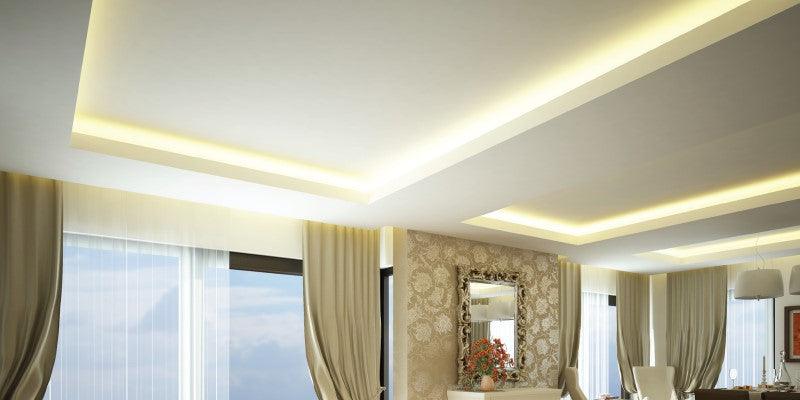Cove lighting, an innovative solution that infuses an ambiance of sophistication and warmth in interior spaces, has rapidly gained popularity in recent years. As a versatile and energy-efficient lighting solution, cove lighting utilizes LED strips cleverly concealed within a cove in the wall or ceiling. As the cove light radiates, it illuminates surrounding surfaces, creating a seamless line of light that subtly reflects into the room. This guide delves into the essentials of cove lighting, offering practical tips to help you select and install the perfect cove lights.

An Introduction to Cove Lighting
Cove lighting is an indirect lighting technique that is typically installed within ledges, recesses, or valances in walls or ceilings. By focusing light upwards towards the ceiling or down the wall, cove lighting generates a soft and ambient glow, creating a cozy and inviting atmosphere. The cove light fixtures are concealed, which contributes to the sleek and unobtrusive aesthetic of this lighting method.
The Advantages of Cove Lighting
Versatility
One of the key strengths of cove lighting lies in its versatility. It is suitable for an array of interior spaces, from residential areas like living rooms, bedrooms, and kitchens, to commercial environments such as lobbies, restaurants, and retail spaces. The design flexibility of cove lighting allows for installation in various shapes, sizes, and colors, presenting endless possibilities for unique and captivating lighting designs tailored to individual preferences.

Energy Efficiency
Cove lighting, especially when LEDs are employed, is renowned for its energy efficiency. Compared to traditional lighting sources like incandescent or fluorescent bulbs, LED cove lights consume less energy and have a longer lifespan. This not only reduces energy costs but also lowers the environmental impact of the lighting system.
Aesthetic Appeal
Cove lighting is an excellent way to accentuate architectural features and enhance the aesthetic appeal of a space. It can be used to highlight specific design elements, create focal points, or add a touch of elegance to a room. The warm and serene atmosphere created by cove lighting can transform the ambiance of a room, making it more inviting and comfortable.

Key Factors to Consider When Installing Cove Lighting
When planning to introduce cove lighting to your space, several factors come into play. These include the location of the cove, the type of LED strips to use, the color temperature of the light, and the reflective properties of surrounding surfaces. Here are some essential tips to ensure the best results with cove lighting:
Location of the Cove and Energy Efficiency
The location of the cove is a crucial determinant of the overall lighting effect. It influences the direction and spread of the light, which can impact the ambiance and aesthetic appeal of the space. Cove lighting can be installed in various locations, including ceilings, walls, or recessed areas—all providing different effects.
It's worth noting that surfaces more absorptive than reflective, such as dark paint or wood, can affect energy efficiency and should be avoided unless energy efficiency is a primary design objective. Instead, opt for reflective surfaces like white walls or ceilings to maximize light output.
Selecting the Correct Light Output
The light output of the LED strip should align with the intended purpose of the cove lighting. Whether for ambient, general, or task lighting, or to accentuate specific objects or architectural elements, the luminous flux per meter is an essential consideration. Here is a general guide:
- Ambient light or highlight of objects, furniture elements: up to 600 lumens per meter.
- Highlight architectural elements: 600-1200 lumens per meter.
- General illumination via lines of light: 1200-2800 lumens per meter, depending on the cove design, ceiling height, and materials used.

LED Strips: Quality, Spectrum, and Color Rendering
LED strips should provide excellent light quality, spectrum, and color rendering index (CRI). The CRI measures how accurately a light source illuminates colors compared to natural light. LEDs with a minimum CRI80 are suitable for all work and living spaces. Full-spectrum, daylight-like light sources with a minimum CRI of 98 are recommended when budget permits.

Longevity and Maintenance of LED Strips
Select LED strips with long lifespans, minimal color shift over time, and excellent lumen maintenance. This will prevent the need for a total replacement if the brightness fades or color temperature changes. For installations with considerable length, these factors are particularly important.
Dimming Option for General Lighting
For cove lights used for general lighting, LED strips that provide high levels of illumination are recommended. However, there may be times when dimmer light is needed, which is why installing a dimming option is essential. Dimming LED strips require both the LED strips and the transformer to be dimmable. Light intensity can then be controlled via an external dimmer.
Integration with Smart Home and Building Automation Systems
Modern cove lighting solutions can be seamlessly integrated with smart home and building automation systems, offering advanced control and customization options. By connecting your cove lighting to a smart system, you can schedule lighting scenes, adjust brightness and color temperature, and even synchronize lighting with other smart devices.
Plan for Maintenance and Accessibility
Like any lighting solution, cove lighting requires maintenance and occasional replacement of components. Design your cove lighting with accessibility in mind, ensuring that LED strips and other elements can be easily reached for cleaning, repairs, or replacements. This will help prolong the lifespan of your cove lighting system and maintain its visual appeal over time.
Consult with a Professional Lighting Designer
While it's possible to plan and install cove lighting on your own, consulting with a professional lighting designer can help ensure the best results. A lighting designer will have the expertise and experience to recommend the most suitable LED strips, transformers, dimmers, and other components for your specific space and requirements. They can also help with the design and installation process, ensuring that your cove lighting achieves the desired effect.





